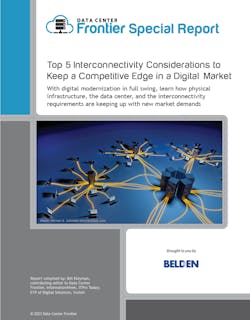How Digital Modernization is Driving the Interconnectivity Evolution
This launches our article series on interconnectivity considerations that will help data center and cloud organizations maintain their competitive edge in a connectivity-driven economy.
In the technology space, leaders in the cloud and data center communities raced to ensure that users had the digital tools they needed to succeed. The result? More modernization efforts, more reliance on digital infrastructure, and more deployments of colocation, hyperscale, and even cloud architecture.
However, the link that ties them all together is interconnectivity.
But unlike the digital booms and connectivity requirements of the past, something feels different today. A recent report from ReportLinker indicates that the global data center market size has witnessed a significant boost since the outbreak of the COVID-19 pandemic across the globe.
The demand for data centers has increased because of the increased access to internet-related services aided by nationwide lockdowns imposed by governments worldwide.
The COVID-19 pandemic has dramatically increased internet traffic by between 25% and 30% during the initial lockdown period (March-April) worldwide, which is 10X times the average growth (~3% per month).
Many of these new connectivity requirements persist today. The bottom line is this: Unlike in the past, we persistently rely on our ability to connect.
This article series will review the industry’s Top 5 Interconnectivity Considerations to help leading data center and cloud organizations maintain a competitive edge in a connected economy. Further, we'll explore new interconnectivity topics, including edge orchestration, interconnectivity automation, innovations in connectivity, and how interconnectivity can be a sustainable form of digital interaction.
Introduction
Welcome to the digital era where you are a digital citizen. We rely on new forms of communication and interpersonal interaction. Doing business has evolved over the past decade, but that evolution hit the accelerator over the past year.
In 2012, we crossed into the zettabyte era, and the data in our digital ecosystem exceeded a zettabyte for the first time. That number continues to increase today, estimated at around 175 zettabytes by 2025.
Your data center is the heart of all this, and your interconnectivity solutions are the veins supporting all of this. Before we jump in, it’s key to under- stand that there has been a fundamental shift in how we deploy technology solutions and where interconnectivity modernization impacts physical infrastructure. Too often, we look at modernization efforts as server upgrades and new pieces of software.
However, the interconnectivity evolution occurs in the data center and cloud infrastructure.
How Connectivity Impacts the New Cloud and Data Center Balance
Today, the world has around 600 hyperscale data centers, many of them mopping up services for small corporations or universities that would have previously had their servers. And there are approximately 6,600+ colocation and wholesale data center facilities across North America, EMEA, Asia-Pacific, and Latin America.
Here’s another point, there have been proven trends in repatriating workloads from cloud computing back to the data center. For the past two years, the AFCOM State of the Data Center report indicated a significant trend in how organizations view cloud solutions. Definitions are blurred as the cloud takes on a broader meaning where it’s not just public cloud solutions.
Per the latest report, nearly 60% report noticing a trend for organizations to move away from the public cloud and looking to colocation or private data centers. Last year, the majority of respondents also indicated this cloud repatriation trend.
What does connectivity have to do with all of this? Our understanding of cloud workloads, where specific resources should live, and how we can plan for the future are vital considerations. The big difference is that there is a better balance between the cloud and the data center.
The other key point is connecting these cloud and data center solutions. With interconnectivity modernization impacting digital infrastructure, it’s essential to explore how our physical components are affected. It’s also vital in supporting a new cloud and data center balance. Ultimately, this means looking more closely at physical infrastructure, ensuring we properly leverage resources while improving ROI and a company’s speed-to-market.
Download the entire report, Top 5 Interconnectivity Considerations to Keep a Competitive Edge in a Digital Market, featuring Belden, to learn more. In our next article, we'll explore how new connectivity requirements create new design and partner considerations.








